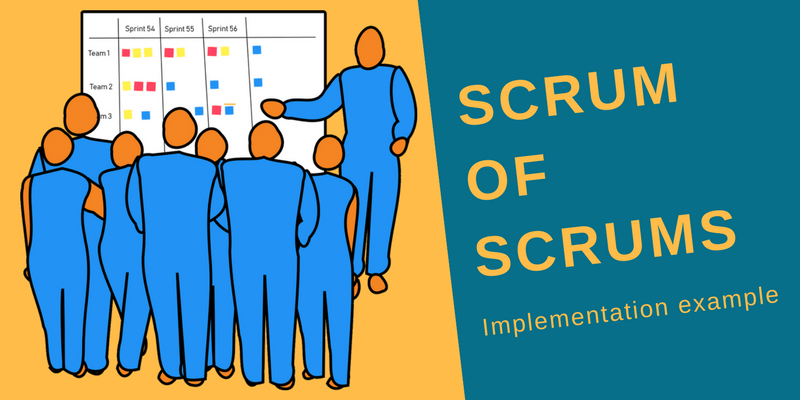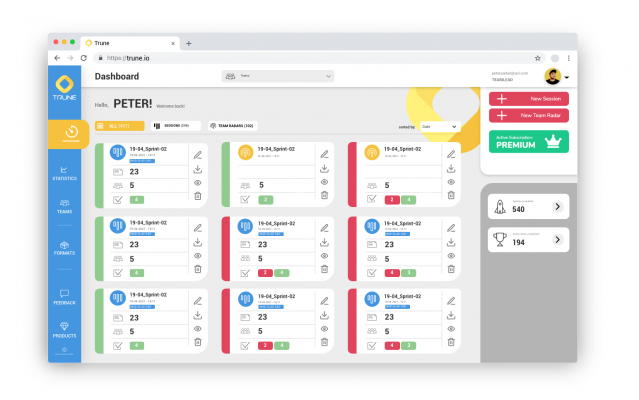The Scrum of Scrums is a meeting on inter-team level with the purpose to surface dependencies between teams and align their collaboration.
In this article I would like to give you insights on how we implemented Scrum of Scrums at LeaseWeb.
I am going to show you a practical example.
I am not going to tell you about the theory behind it, because you can find such information in other places on the Internet.
I want to give you some practical insights on how Scrum of Scrums can be implemented, what tools we are using and the benefits and downsides we get out of it.
However, before we start, I would like to explain in a few sentences what Scrum of Scrums actually is.
Scrum of Scrums
The Scrum of Scrums has a similar purpose as the daily standup in a Scrum team. The difference is that the Scrum of Scrums is done on an inter-team level. This means, that a representative of each Scrum team is joining the Scrum of Scrums.
Similar as in the daily standup of a Scrum team, in the Scrum of Scrums each team representative has to answer three questions:
- What impediments does my team have that will prevent them from accomplishing their Sprint Goal (or impact the upcoming release)?
- Is my team doing anything that will prevent another team from accomplishing their Sprint Goal (or impact their upcoming release)?
- Have we discovered any new dependencies between the teams or discovered a way to resolve an existing dependency?
If you want to learn more about the Scrum of Scrums, then I recommend to have a look at the Scrum@Scale guide. That´s also the place where the three questions come from.
The Scrum@Scale guide has been published recently (February 2018) by one of the fathers of Scrum, Jeff Sutherland.
This is definitely a good starting point to learn more about scaling Scrum.
Ok, let´s have a look on how we implemented Scrum of Scrums at LeaseWeb.
Scrum of Scrums implementation
I have been working at LeaseWeb for a couple of years. To give you a more practical insight, I would like to explain how we implemented the Scrum of Scrums at LeaseWeb.
12 Scrum Teams
At LeaseWeb there are 12 Scrum teams. Each team is responsible for a certain service or product and naturally there are often dependencies between the teams.
For instance, when building a new feature a couple of teams might be involved and have dependencies with each other. To realize the new functionality several teams have to make changes in their product. Therefore close collaboration is required. And that´s why Scrum of Scrums has been implemented.
Big board in the hallway
We have a big board in the hallway, where everyone can see it when walking by. So, if people from other departments are interested what the development teams are currently working on, they can have a look at this board.
And the board is really big, actually it is a whole wall. If you want to know the dimensions, then I would say it is about three meters high and six meters wide. It is quite an impressive view when you enter the floor of the development department.
The board is basically a big table with columns and rows. There are columns for the current sprint n, the next sprint n+1, sprint n+2 and sprint n+3. In addition there are also columns for the next months and the next quarter.
While the columns are used to display the time, each team gets a separate row in the table and fills it with cards.
The cards
The cards contain information on a high level on what each team is doing the current sprint as well as what the teams are planning to do in the upcoming sprints.
The level of detail is higher in the current sprint and obviously decreases the more you plan in the future.
So it is totally fine to just have one card in the next quarter column, which has for instance promo written on it. This should indicate that the team plans to work on a promotion feature in the next quarter. But it is important to understand that this is the high-level plan from todays perspective. It is not written in stone and it might change – in fact it is very likely to change, because it is very difficult to plan ahead for such a long time.
However, the team should have a more detailed plan on what they are working in the upcoming sprint, especially if they have dependencies with other teams. So they can coordinate and resolve those dependencies as good as possible.
But even though the plans might change in the future, it is good to have the card on the board, because it triggers discussions with other teams and stakeholders on what is the most important thing to work on and where do we have inter-team dependencies.
The cards are magnetic and stick on the board. You can write on them with a whiteboard marker and after cleaning you can reuse them again. We also use different colors for different projects or epics. You can find those magnetic cards on Amazon and also the lines you can use build the table on the board can be found here.
The Scrum of Scrums meeting
The Scrum of Scrums meeting itself happens once a week and is timeboxed to 15min.
A representative of each team explains what the team is doing in the current sprint and the plans for the upcoming sprint – answering the three questions, which I mentioned above. As there are 12 teams it is crucial to keep it short and don´t get into details.
In general, the focus during the explanations are the dependencies with other teams. All other details are left out.
In case there are no dependencies with other teams, then the most important goals of the team are mentioned. I usually name the sprint goal of my team there as well. Nonetheless, as I already said, the key is to keep it short.
If there are any questions during the explanation, then those are answered right on the spot, if the answer is short. In case the answer needs a more detailed explanation, then the answer is postponed after the Scrum of Scrums and people, who are interested stay after the end of the meeting to hear and discuss the details.
If the answer triggers a discussion during the Scrum of Scrums, then any of the present Scrum Masters is allowed to interrupt the discussion, and asks the participants to discuss the topic after the meeting. That´s how it is possible to keep the timebox of 15min – even though there are 12 teams.
Benefits and downsides
Let´s start with the downsides of having a Scrum of Scrums meeting.
Well, everyone is busy with his own work and has a tight schedule and there comes another meeting what you have to attend. And even though it is just 15min you need some time to prepare the board. In addition, you need to interrupt your normal work and therefore also loose some focus time, because of the content switch – before and after the meeting.
- But next to that there are also quite some benefits of having the Scrum of Scrums in place.
First of all, having this formal process in place, which forces you to think and explain what you are working on and what you are planning to do.
- And just by that you might encounter impediments with other teams earlier. So you are able to work on resolving them, before those impediments become a blocker within your team. This is going to save your team a lot of hassle, nerves and time.
- Another great benefit is that you hear what other teams are working on.
And you might have better insights why they are not able to work on the tasks your own team depends on.This gives you a better understanding of the overall direction the whole department is going and the goals the teams are working towards.
The Scrum of Scrums also fosters collaboration between teams.
I recall multiple occasions that after the meeting I went to other teams to ask for their help or somebody came to me with information I didn´t know yet.
For instance, my team planned to work on a new backup solution, which I explained briefly during the meeting. Afterwards another Scrum Master poked me and told me that his team already has something similar in place.
Finally, the two teams ended up working together on a solution and with the knowledge provided from the other team it was way easier for my team to implement a good solution.Without the Scrum of Scrums we would have probably worked on it by ourselves and present the solution after the sprint. And only then we would have figured out that we already had the knowledge and infrastructure in the department and we just did the work twice.
Closeup
In this article I gave you an overview on how we implemented Scrum of Scrums at LeaseWeb. I have explained what tools we are using and what benefits and downsides we get out of it.
Do you have Scrum of Scrums in place in your company as well? What are the differences compared to the implementation at LeaseWeb?
Or you don´t have Scrum of Scrums in place in your company yet and you plan to implement it? Let me know how it works!
Ok, that´s it for today. Stay tuned and HabbediEhre!

